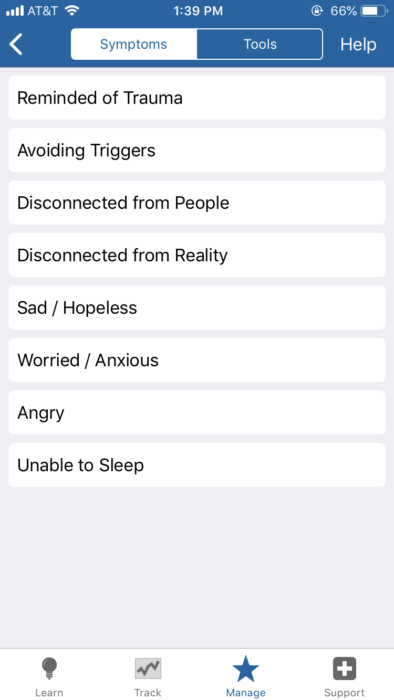Did you know that 3.5% of U.S. adults have been diagnosed with PTSD (post-traumatic stress disorder)? Said individuals often experience flashbacks to past traumatic event(s). Stir in a few more major stressors and voila! you have the recipe for an endless amount of panic attacks. If you or a loved one has a history of panic attacks and/or PTSD, check out the app PTSD Coach.
PTSD Coach is an app designed by the Veterans Administration. It is ideal for individuals who have anxiety, depression, panic disorder, PTSD, and more. PTSD Coach has a tool for assessing and managing symptoms so you can easily evaluate and try to manage the severity of symptoms.
When you first download the app, you can personalize it by selecting soothing pictures (for me, I selected pictures of my sweet doggo, Winifred, of course.) You can also choose soothing songs, mindful pictures/songs, and then support contacts. After you personalize the app, you can select one of the four options:
- Learn
- Track Symptoms
- Manage Symptoms
- Get Support
About PTSD:
Before diving further into the app, I would like to first discuss PTSD. I used to think only veterans experience the disorder, but that is not the case at all. Here’s the harsh reality: virtually anyone can develop PTSD. Here are a few interesting statistics:
- About 20% of women and 8% of men will develop PTSD after a trauma
- Certain types of trauma (abuse, combat, etc.) can cause even higher rates of PTSD
- About 7% of the US population will have PTSD in their lifetime
- Women are twice as likely as men to develop PTSD
According to the app, PTSD is caused by “witnessing, experiencing, or learning about someone close to you who experienced traumatic events (such as actual or threatened death, serious injury, or sexual violence.)” There are some factors that make getting PTSD more likely.
- Risk factors before a trauma that may contribute:
- Past trauma(s)
- Being female
- Having been abused as a child
- Pre-existing mental health problem(s)
- A family history of mental illness
- Risk factors during a trauma include:
- Believing you are going to die
- Feeling detached from yourself and/or your surroundings
- Having a panic attack
- Feeling completely helpless
- Being seriously injured
- Risk factors after a trauma:
- Lack of social support
- Additional life stresses (e.g. job loss, divorce, etc.)
Track Symptoms of PTSD:
In addition to answering and defining many aspects of PTSD, the app offers a tool called “Track Symptoms”. The self-assessment in this app is called the “PTSD Checklist” or “PCL-5” for short. “This scale has been used with people with PTSD for screening, diagnosis, and monitoring for many years and has been scientifically validated.” It was developed in the early 90s by the National Center for PTSD.
Disclaimer: This assessment cannot tell you if you have PTSD; only a trained mental health provider can do that. However, it can give you some valuable information about how severe your symptoms are, and if you’re getting better or worse over time.
The test consists of 20 questions with 5 possible answers. An example of a question is, “In the past month, how much were you bothered by: feeling very upset when something reminded you of the stressful experience?” Answers vary from Not at all to Extremely.
Manage Symptoms of PTSD:
Under the “Manage Symptoms” category, the app lists multiple symptoms you may be experiencing (e.g. anger, disconnection from reality, etc.) The following images are screenshots taken from the Manage Symptoms tool.

Here’s how it works: if you select “Reminded of Trauma”, you’ll be asked to select the severity of your distress. Once you do that, it’ll give you some guidance on what to do. For me, I selected a 7 so it provides soothing audio and instructs me to do the following:
“Pay attention entirely to the sounds of the song. Do not label the sounds or think about their meanings. If your mind wanders, return to listening as soon as you realize it.”
Get Support:
The final tool available within the app is the “Get Support” tool. Here you’ll find several resources: Crisis Resources, Find Professional Care, and Grow Your Support.”

